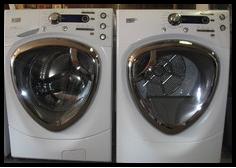How Washers Work
Knowing how washers work is very important specially if you are going to attempt to work on your washer, it is best if you understand
how washers work. On this page, I will describe how both front loading washers
work and how top loading washers work.
Top Loaders
Fill
Cycle
First, the washer will enter into a fill cycle. This is
when the water will come in. The water valve will energize allowing cold and hot
water into the washer depending on the water temperature you selected. The water
will continue to run until the level inside has reached the point that the water
level control is satisfied. Water valves and water level controls can be
purchased at AppliancePartsPros.com.
Wash Cycle
Once the water
reaches the desired level, the washer will enter the wash cycle. This is when
the washer agitates the clothes in soapy water by rotating the agitator
back-and-forth continuously. In order for agitation to take place, the tub needs
to be held in place by not releasing the brakes. The motor turns the
transmission pulley and gears inside the transmission rotate the transmission
shaft back-and-forth and the transmission shaft rotates the agitator
back-and-forth. The washer cycle will last anywhere from six to twenty minutes.
These parts can be purchased at AppliancePartsPros.com.
Pump Out Cycle
Once the wash
cycle is over, the washer will enter the pump out cycle. During the pump out
cycle, the water pump will pump all the water out of the tub. Water pumps can be
purchased at AppliancePartsPros.com.
Spin Cycle
Once the water is
pumped out, the washer will enter the first spin cycle. During the spin cycle,
the tub rotates at speeds anywhere from 800 rpms to 1200 rpms. This will ring
all the water out the clothes. In order for spin to take place, the brakes must
be released, which will allow the motor to rotate the whole transmission (rather
than just the gears) and the tub.
Rinse
Cycle
During the rinse cycle the tub will fill (normally with
cold water) then agitate again. The rinse cycle is mainly to get all of the soap
out of the clothes.
Final Spin
After the rinse
cycle the washer will enter the final spin. The final spin will remove all of
the water from the clothes. After the final spin the clothes will be damp (not
dripping wet) and ready to enter the dryer.
Front Loaders
In this section of my how washers work guide I will explain how front load washers work.

Fill Cycle
First, the washer will enter into a fill
cycle, which is when the water will come in. The water valve will energize
allowing cold and hot water into the washer depending on the water temperature
you selected. The water will continue to run until the level inside has reached
the point that the water level control is satisfied. Water valves and water
level controls can be purchased at AppliancePartsPros.com.
Wash Cycle
On a front-loading
washer, the tub will rotate so slow that the clothes will fall down halfway
through a rotation. Unlike top-loading washers, front loaders don't have a
transmission and most of them don't have brakes. The motor connects directly to
the tub. The door will stay locked throughout the entire wash cycle for safety.
The clothes must strike the bottom of the tub when they fall in order to clean
them efficiently. Soapsuds will prevent this from happening. This is why you
must use high efficient detergent because it doesn't create soapsuds.
Pump Out Cycle
Once the wash cycle is
over, the washer will enter the pump out cycle. During the pump out cycle, the
water pump will pump all the water out of the tub. Water pumps can be purchased
at AppliancePartsPros.com.
Spin Cycle
Once the water is
pumped out, the washer will enter the first spin cycle. During the spin cycle,
the tub rotates at speeds anywhere from 800 rpms to 1200 rpms. This will ring
all the water out the clothes. Because there are no brakes, the door will stay
locked throughout the entire spin cycle and the tub has come to a complete
stop.
Rinse Cycle
During the rinse cycle, the tub
will fill (normally with cold water) then wash again. The rinse cycle is mainly
to get all of the soap out of the clothes.
Final
Spin
After the rinse cycle, the washer will enter the final
spin. The final spin will remove all of the water from the clothes. After the
final spin the clothes will be damp (not dripping wet) and ready to enter the
dryer.
I hope that this page helped you better understand how washers
work and you can use this page along with my washer repair guide to repair your
washer. If this page didn’t help you visit my
frequently asked washer questions page. Or return to my washer repair guide for more repair pages.